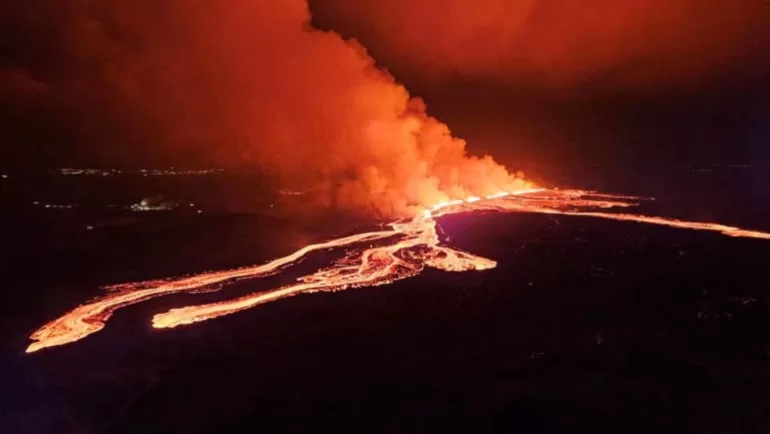The eruption was the fifth to occur on the peninsula since December.
“An eruption has started near Sundhnuksgigar, north of Grindavik,” the Icelandic Meteorological Office (IMO) said in a statement on Wednesday, almost three weeks after the end of a previous eruption that had been ongoing since March 16.
“The eruption cloud reached an altitude of about 3.5km [2.2 miles] at the beginning of the eruption,” which created a fissure that was estimated to be more than 1km (0.6 miles) long, it added.
A large white cloud of smoke could be seen billowing up against a blue sky. Volcanologist Benedikt Ofeigsson told Icelandic public broadcaster RUV the fissure was growing and was more than 2.5km (1.6 miles) long an hour after the start of the eruption.
The nearby Blue Lagoon, Iceland’s biggest tourist attraction, known for its turquoise waters, said it had evacuated its facilities on Wednesday.
The eruption was, however, not expected to disrupt air traffic with the international airport Keflavik “open and operating in the usual way”, airport operator Isavia said on its website.

The IMO had reported “intense earthquake activity” before Wednesday’s eruption with “about 400 earthquakes” measured in the past seven days near the Sundhnuksgigar crater row.
In addition, it said about 20 million cubic metres (26 million cubic yards) of magma had accumulated in the magma chamber below Svartsengi, the area where a power plant that supplies electricity and water to 30,000 people on the peninsula is located.
The Svartsengi plant was evacuated and has largely been run remotely since the first eruption in December, and barriers have been built to protect it.
Most of the 4,000 residents of the nearby town of Grindavik were permanently evacuated in November.
Lava flowed into the streets of Grindavik during the January eruption, engulfing three homes. But a few die-hard residents had returned to live in neighbourhoods less at risk from lava flows.
Until March 2021, the Reykjanes Peninsula had not experienced an eruption for eight centuries.
Further eruptions occurred in August 2022 and in July and December last year, leading volcanologists to believe the start of a new era of seismic activity in the region had begun.
Coast guard helicopters had been sent up to determine the exact location and size of Wednesday’s eruption.
Iceland is home to 33 active volcano systems, the highest number in Europe.
It straddles the Mid-Atlantic Ridge, a crack in the ocean floor separating the Eurasian and North American tectonic plates.
